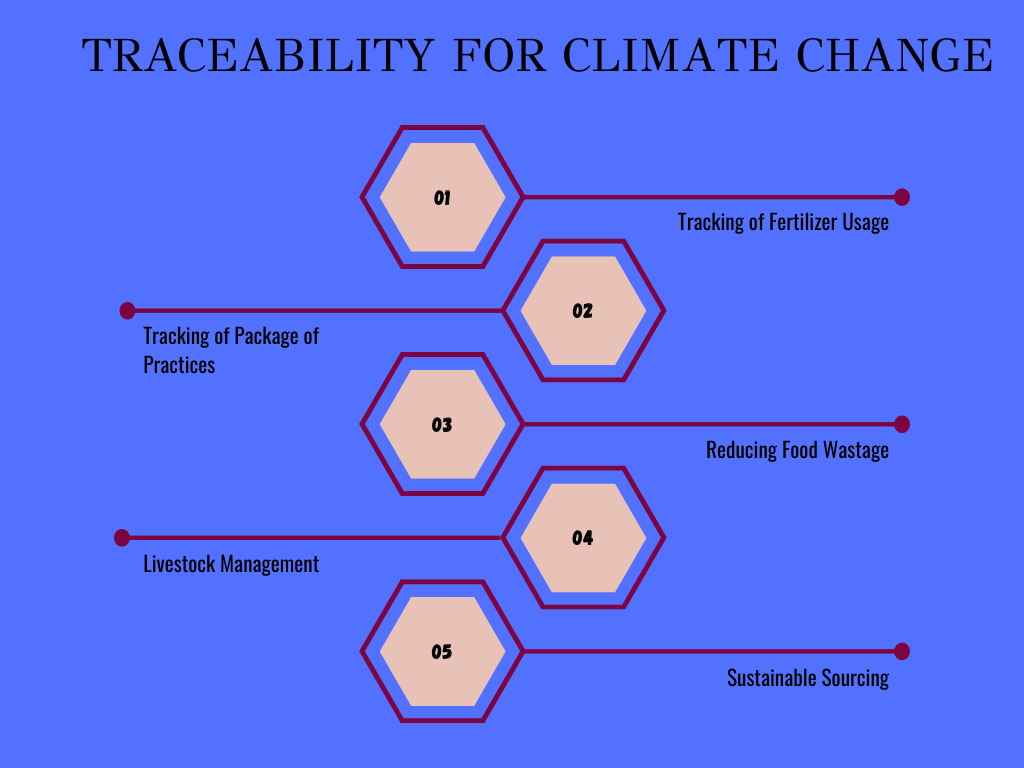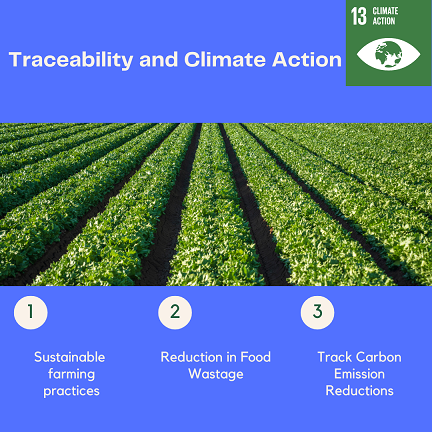Contact: +91 99725 24322 |
Menu
Menu
Quick summary: Discover the powerful role of traceability in driving climate action. Explore how TraceX's innovative traceability solutions are empowering businesses to reduce their environmental impact and achieve sustainability goals. Uncover the key benefits and insights that traceability brings to the table, and learn how it is revolutionizing the way companies approach climate action.

In the face of the growing climate crisis, the role of food traceability has emerged as a powerful tool in driving climate action and promoting sustainability in the food industry. As consumers become increasingly conscious of the environmental impact of their food choices, businesses are under pressure to adopt transparent and accountable practices throughout the supply chain.
According to FAO, global food waste produces 3.3 gigatons of CO2 equivalent emissions annually.
Food traceability with its ability to track the journey of food from farm to fork, plays a vital role in empowering stakeholders to make informed decisions that reduce carbon footprints, promote sustainable sourcing and combat deforestation. In this blog, we try to find out why traceability is important for addressing climate action and how it can help us to build a climate resilient, sustainable food system for the future. Join us on this journey to explore the transformative potential of food traceability in fostering a climate-friendly food system.
Food traceability is the ability to track and monitor the movement of food products from the origin at the farm through every stage of production, processing, transport, distribution and sale to the end consumer. It provides transparency and accountability in the supply chain, thereby ensuring food safety, enhance productivity and quality yields.
Traceability starts at the farm, where the location of the farm, the crop varieties, the crop and harvest calendars along with the production methods are recorded. Further to this the processing stages, transport and storage details and the quality control applied is monitored. The final details on the shipment, transportation, receiving party and final sale to consumer is the last stage in the supply chain that is tracked.
The end-to-end traceability ensures accountability among the stakeholders and identify problems like foodborne disease outbreaks, quality issues and supply chain disruptions. Tracking and monitoring of this information in real-time ensures food safety and promotes sustainability.
Blockchain powered traceability establishes trust in the ecosystem with a single source of truth and delivering a digital identity to the product. The real-time data capture aids in product recalls, food loss and supply chain disruptions.
The way we produce and consume food is inextricably connected to the earth’s changing climate.
Agriculture is a large contributor to greenhouse gas emissions. Along the food supply chain, the various activities and products are associated with varying degrees of GHG emissions, known as the Carbon Footprint which contribute to climate change While land-based agriculture seems to lose quite a bit from rising temperatures, oceans are also vulnerable to damage from global warming.

The ways in which crops are grown, the manner in which animals are reared, agriculture activities like manure treatment, usage of synthetic fertilizers and use of farm equipment all add to the greenhouse gas emissions. Carbon dioxide gas is the prominent gas released that increases the planet’s ability to retain heat and cause global warming. The other GHGs released are methane from livestock and nitrous oxide from synthetic fertilizers. Burning of fossil fuels and deforestation also releases the greenhouse gases into the atmosphere.
The production of synthetic fertilizers contributes to carbon dioxide emissions and its usage contributes to nitrous oxide emissions which is another potent gas. The methane released during Enteric Fermentation is 25 times more potent than carbon dioxide. The synthetic chemicals hurt the microbial activity in soils thereby reducing soil fertility.
The synthetic nitrogen fertilizers are produced from fossil fuels and are used extensively in conventional crop production. The use of these fertilizers contributes to about 13% of agriculture GHG emissions.
Farming practices like tilling can expose the soil and unlock the carbon stored leading to soil erosion. Two-thirds of the available agriculture land worldwide is used for animal production through land for grazing and land used for feed crops.
Deforestation is another critical factor in some commodity supply chains like the soy, palm oil and timber. This affects the water cycle and the cutting of trees release the sequestered carbon contributing to climate change. Deforestation also disrupts the biodiversity in the ecosystem threatening extinction of several species.
The rising temperature and the change in precipitation patterns decrease crop productivity, cause soil erosion and affect the water and nutrient cycles for crop growth.
Temperature variations cause a proliferation of weeds. Pests thrive in warmer conditions could pose a threat to crop production. This may necessitate pesticide use.
Temperature fluctuations also affect animal health and affects production of milk, eggs and other livestock products. Extremities in weather like drought and flooding can decrease livestock producivity
Traceability is the ability to track products from source to consumption along a supply chain and in the context of GHG emissions, traceability can help to measure and monitor the emissions by providing the information on sources of emissions and the various activities that contribute to the same.
The farm level activities include usage of inputs and the production of crops and livestock. Traceability can be used to track the inputs and outputs of farming activities. It is possible to collect the data and calculate the emissions at each stage of the process. There could be emission arising from fertilizer production, machinery used, transportation, emissions from manure, enteric fermentation and livestock feed.
The adoption of sustainable farming practices helps to reduce the emissions identified.

The reduction in fertilizer use helps to reduce emissions due to fertilizer production. Tracking the use of fertilizers and pesticides with traceability can help to identify areas where emissions can be reduced. The farmers can identify areas where they can reduce the chemical usage by implementing sustainable practices or using alternatives. The use of sensors and drones helps to monitor crop growth and with precision agriculture, the farmers can reduce the use of chemicals and thereby reduce emissions.
Agriculture practices like cover crops, crop rotation improves soil health and helps to sequester soil carbon. Enhancing soil health with these diverse sustainable practices builds resilience into the food ecosystems. Traceability systems helps to monitor crop growth through package of practices that can be configured and monitored to track deviations.
It is estimated that annually, one-third of all food produced for consumption never reaches the consumer’s table. This is indeed a waste of natural resources used for growing, processing, packaging, transporting and distribution of food.
Thus the total carbon footprint of food wastage including land use change is around 4.4Gt Co2 eq per year. Reducing food loss and waste at every stage in the supply chain can cut down the land we need to grow food and reduce the emissions.
According to FAO, global livestock is responsible for 14.5% of anthropogenic GHG emissions with 65 % of global nitrous oxide emissions and 37% of global methane emissions.
Traceability systems can provide information on the amount of feed, water and other resources used to raise livestock as well as the amount of emissions released during its production. This helps farmers to take informed decisions and manage their livestock in a sustainable way. The issues related to animal welfare, detecting and preventing disease outbreaks and reducing use of antibiotics and manure management can be realized in a sustainable way with traceability solutions.
Traceability drives sustainable sourcing, and this can be instrumental in reducing emissions in the agriculture industry. Companies can use traceability to track the origin of their products and ensure that they are sourced from sustainable farms that use environmentally friendly practices. This helps to reduce the emissions and drive sustainability.
Traceability helps to reduce emissions and its accurate measurement and reporting enables organizations to demonstrate sustainability to consumers and other stakeholders. This would help all the stakeholders to work together to achieve a low carbon economy.
In Carbon markets, traceability provides a system to track the emission reductions or removals associated with specific projects and activities. These reductions or removals are measured in terms of carbon credits that can be bought and sold by companies and governments to offset their emissions. Traceability ensures the accurate quantification and verification of these carbon credits. Third party verification processes and standardized methodologies ensure that the credits represent real and additional emissions or reductions. Traceability brings integrity into the carbon markets by preventing double counting and fraud in the voluntary carbon market.
According to Ecosystem marketplace, the Voluntary Carbon market that allows companies to purchase carbon credits to offset their own emissions is expected to grow to $50 billion per year by 2030
The demand for carbon credits is expected to increase significantly as more countries are setting ambitious climate targets and seeking to achieve net-zero emissions by 2050.
Traceability is also important for tracking ownership and transfer of carbon credits and ensuring that the projects and activities generating these credits are sustainable and aligned with the sustainable development goals. Blockchain provides a secure and transparent way to track the ownership and transfer of carbon credits. Several blockchain platforms have evolved for carbon trading, ensuring the environmental integrity of carbon markets.
TraceX’s traceability solutions play a pivotal role in helping companies address climate action through its sustainability and carbon management platform Trace Carbon. Through its comprehensive traceability features, TraceX enables companies to track and manage every step of their supply chain, from sourcing to production and distribution. With the ability to precisely track materials and inventory, companies can optimize their resource usage and reduce waste, leading to more sustainable practices. The platform’s seamless integration of blockchain technology ensures transparent and secure data sharing among stakeholders, fostering collaboration and promoting accountability.
Trace Carbon equips companies with the necessary tools to set and achieve climate goals by monitoring and reducing their carbon footprint. By gaining visibility into their environmental impact, companies can identify areas for improvement and implement targeted initiatives to reduce emissions and drive climate positive action. The DMRV tool brings credibility in the carbon offset markets.

Paul Polman, former CEO of Unilever says, “Traceability is the foundation of Sustainability. Without the ability to trace where our products come from and how they are made, we cannot hope to build a sustainable future that protects both people and the planet.”
Traceability plays acritical role in supporting climate action by providing a reliable and transparent system for tracking emission reduction and removals and ensuring integrity in carbon markets.
Traceability is key to transitioning to a low carbon economy and supporting the global efforts to mitigate climate change.
